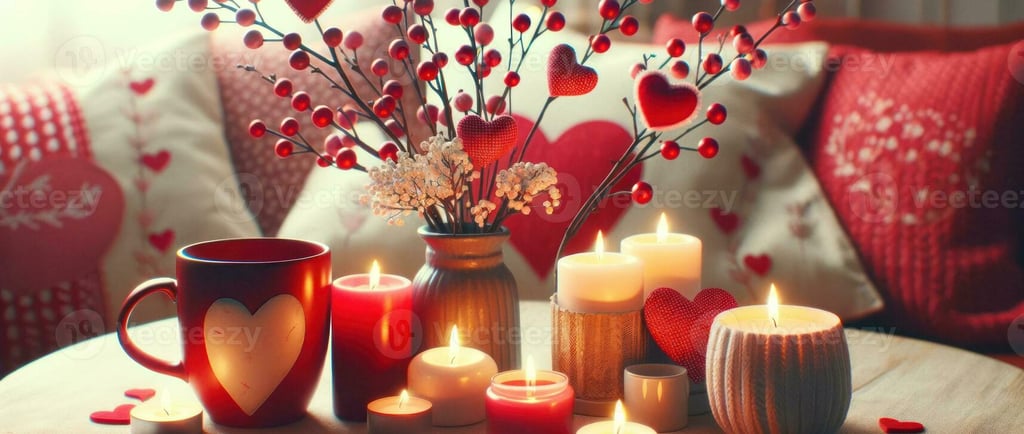Love in Bloom: The Rise of Valentine's Home Decor in 2025
SEASONAL
Kelley Busbice
8/25/20254 min read


Love in Bloom: The Rise of Valentine's Home Decor in 2025
As February's chill settles in, homes are warming up with the glow of Valentine's Day decor. From plush heart pillows to twinkling fairy lights and blush-pink tablescapes, this holiday's aesthetic has shifted from subtle accents to full-on romantic celebrations. The trend is soaring, with people splurging on artisanal wreaths, custom banners, and cozy throws. Why are we seeing such enthusiasm for February decorating? This blog dives into the evolution of Valentine's home decor, explores why it's gaining traction, and reveals who’s buying these love-infused pieces—and what drives them. Plus, we'll spark your urge to shop for that perfect romantic touch.
The Evolution of Valentine's Day Decor: From Ancient Rites to Modern Romance
Valentine's Day decor has deep roots. In ancient Rome, mid-February marked Lupercalia, a fertility festival where homes were adorned with evergreens to symbolize renewal. By the 5th century, the Christian church reframed it to honor St. Valentine, a martyr tied to romantic love, with handwritten notes becoming early tokens of affection. In the Middle Ages, poets like Chaucer linked February 14 to lovebirds, inspiring handmade valentines with lace and ribbons.
By the 18th century, England saw mass-produced cards with cupids and flowers, laying the groundwork for decorative traditions. The Victorian era turned Valentine's into a sentimental spectacle, with homes showcasing pressed blooms and heart-shaped trinkets for elegance and emotion. The 20th century brought commercialization, with Hallmark's 1910s greeting cards and florists pushing roses as love's emblem. Post-WWII, decor expanded to balloons, streamers, and themed parties. Now, in the digital age, Pinterest and Instagram fuel creativity with DIY wreaths and LED-lit vignettes, making decor accessible and aspirational. Today's inclusive themes embrace self-love, friendships, and family, with eco-friendly and personalized touches reflecting modern values.
Why People Are Steadily Getting More Involved in February Decorating
February's decor surge is no fluke—it's a cultural shift. After the pandemic, homes became sanctuaries, and decorating became a way to lift spirits during winter's gray days. With remote work still common, people crave visual warmth, and pinks, reds, and rose golds deliver just that. Social media amplifies this, with influencers sharing "decorate with me" videos on TikTok and YouTube, inspiring fans to recreate romantic setups. Search terms like "Valentine's tree decorations" have skyrocketed, showing a preference for immersive experiences over fleeting gifts.
Economic factors help too. Despite inflation, affordable decor from Dollar Tree or Amazon lets anyone refresh their space on a budget. Valentine's has also broadened beyond couples—more people celebrate self-love, friends, or pets, making decor a universal joy-spreader. Sustainability trends encourage reusable items like heart vases that double as spring accents, extending the holiday's appeal. In 2025, Valentine's spending is projected to hit $27.5 billion, with a significant portion fueling home decor, as people prioritize creating cozy, love-filled environments.
The Typical Valentine's Decor Buyer: Profiles and Motivations
Who’s grabbing those heart garlands? Millennials aged 25-34 lead the pack, with 62% celebrating enthusiastically, while 35-44-year-olds spend the most on gifts and decor. Gen Z is close behind, with 71% of young couples shopping, often online. Married couples with kids dominate floral purchases, but singles are increasingly buying for themselves, embracing self-love.
Motivations are heartfelt. For many, decorating is an act of love—creating a warm atmosphere for partners or family fosters connection. Parents enjoy building traditions, hanging heart garlands or crafting with kids for bonding. Child-free adults decorate for personal joy, countering post-holiday blues or simply because it "feels happy." Nostalgia plays a role, evoking childhood crafts, while others find decorating therapeutic—a creative escape from daily stress. Social media-driven FOMO pushes some to elevate their spaces, blending personal expression with shareable aesthetics.
Why You Should Shop for Valentine's Decor Now
Picture your home bathed in the soft glow of rose gold fairy lights, a lush heart-shaped wreath welcoming guests, instantly melting away February’s chill. Valentine’s decor isn’t just about looks—it’s about crafting moments that linger, whether for a romantic dinner or a cozy self-care night. Budget-friendly finds like $3 heart garlands at Dollar Tree or handcrafted wooden signs on Etsy fit any style or wallet. Transform your mantel with a velvet throw blanket or set a dreamy table with burgundy napkins and floral centerpieces. Stores like Target and Amazon are brimming with the hottest picks, and post-Christmas sales make now the perfect time to snag deals. Why wait? Start shopping to create a love-filled vibe that lasts all month.
The beauty of Valentine’s decor lies in its versatility and sustainability. Choose reusable pieces like ceramic heart vases or mini pillows that seamlessly transition into spring, stretching your investment. Whether you’re a DIY fan crafting custom banners or grabbing pre-made kits from Hobby Lobby, decorating becomes a love letter to your home. With online shops buzzing with inspiration and local craft stores offering workshops, there’s no better time to dive in. Make your space a romantic retreat—your heart will thank you for the glow.
Trends: Romantic and Versatile
This year’s trends lean into soft pinks, burgundies, and rose gold, with bows, heart vases, and throw blankets stealing the show. Eco-friendly touches like wooden signs and mini pillows blend romance with everyday use. Start decorating early—post-Christmas—for maximum enjoyment and to beat the rush.
Wrapping Up with Hearts
Valentine's home decor has evolved from ancient rites to a vibrant expression of love in all its forms. Its rising popularity stems from emotional needs, social media inspiration, and inclusive celebrations, drawing in millennials, families, and singles alike. Whether for romance or self-care, February’s flair proves love is in the details
Trends
Explore luxury home decor trends and guides.
info@platinumplacehomedecor.com
© 2025. All rights reserved.


